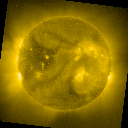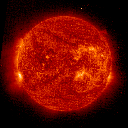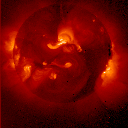| Copyright |
| 2002 10sd116 Israel. Alls rigths reserved. |
Actividad AuroralAurora is caused by interaction between the Earth's magnetic field and the solar wind (a mix of charged particles blowing away from the sun).During solar storms, enough of these charged particles make it through to the Earth's upper atmosphere that they interact with the earths natural magnetic field lines. When enough of these particles collide, energy is released in the form of auroral light. In addition to creating a pretty light show (mostly in upper latitudes), radio signals scatter off of these particles and can greatly enhance propagation on 6 meters and above. High levels of aurora can also make propagation via polar routes difficult.
Click on thumbnails to view a
larger image Solar X-Ray FluxThis chart shows X-ray flux levels as measured by the GOES-8 and GOES-10 satellites. The GOES-8 measurements (shown in red) are used to issue "solar alerts" when X-ray flux levels exceed certain levels. Spikes on the chart correspond to solar flares. Flares are considered "significant" when flux levels rise above the "M" level (as shown on the right side of the chart). These large flares can often wipe out the bands almost immediately and it can take minutes to hours for the bands to recover. If the bands seem to go dead all of a sudden, it is always a good idea to check this chart to see if a large flare has occurred recently. Dynamically updating plots: The following map shows Maximum Usable Frequencies (MUFs) for 3000 kilometer radio signal paths.More importantly, the current sunspot number (SSN) and Planetary A-index are updated every 30 minutes on the bottom of this image. Additionally, the grey line position, auroral ovals, and sun position are provided. Click on the map for more details on how to use it. This image courtesy of Solar Terrestrial Dispatch Current Solar ImagesThe images below are current views of the sun shown at different wavelengths of light as taken by SOHO and the Yohkoh soft-Xray telescope. Generally, more bright regions on the disk indicates more solar activity, which usually leads to higher solar flux levels (which usually leads to better propagation!). Click on any thumbnail to view a larger image.
Sometimes you may see "CCD Bakeout" instead of the solar disc images. This occurs when NASA does routine maintenance and calibration on the cameras. For a more technical explaination, read NASA's CCD Bakeout explaination. Images courtesy of the Solar Data Analysis Center at the NASA Goddard Space Flight Center |
| PROPAGACION: |
| --> |
| Indice principal |










